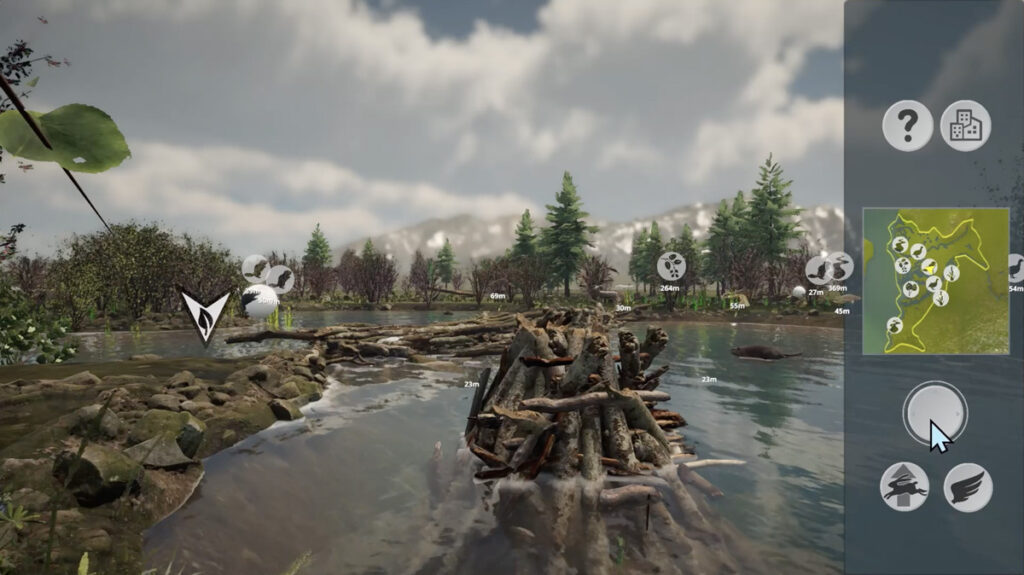Aleksandra Dulic. Juried Artist
Artist Statement
Okanagan Waterways visualization explores the nature of our relationship with water – from the impact of development on the environment to the importance of traditional ecological knowledge in ensuring all living things have clean waternow and in the future. In keeping with Syilx environmental ethicsthe Okanagan Waterways reminds us that we all have a responsibility to work towards building and upholding the sustainability of water for healthy ecosystems and future generations.
Waterways exhibit allows visitors to experience a touch screen and audio dispersion displaying interactive 3D visualizations of Okanagan landscapes and waterways before colonial development that show dramatic ecological changes to flood plainswetlands and riparian habitats in the last 100 years. Visualizations depict the entire core of the city of Kelowna between Mission Creek and Mill Creek floodplain. The locales focus on the historical characteristics of Mission CreekMill Creektheir tributary creekswetlands and the floodplain areas of the Okanagan Lake system. The touch-screen interface affords exploration of the diverse and sensitive Okanagan ecosystemsincluding plantanimaland insect species indigenous to the region. The interactive virtual environment enables the exploration of two layers: historical and contemporary. It overlays the current urban and agricultural development over ecological history visualizationsproviding an essential understanding of what we have lost and how much we have transformed our environment. The information and stories embedded in the visualizations offer a creative platform for dialogue and learning diverse cross-culturalcommunity-basedpoetictraditional and scientific water knowledge and values.
Waterways 3D visualizations use a research-creation approach to bridge scientificIndigenousartisticand humanistic perspectives within a media-richdata-driven immersive environment. The Waterways demonstrates how the research-creation method enables articulation and exploration of the nature of human-water relationships in the Okanagan ValleyBritish Columbia. The resulting visualizations employ immersive technologies and software design to form a platform for dialogue across community-basedpoetic and scientific water knowledge. The project synthesizes essential water knowledge and research to catalyze ecological awareness and promote sustainable water use practices among Okanagan residents. By weaving together multiple community storiesdiverse water knowledgeand artistic expressionsthe visualizations provide a setting for our complex local understanding of water. Acknowledging the sustainable practices of the Syilx Okanagan people as stewards of this landwe engage in a design methodology for creating an experiential learning environment that aligns with the holistic approach critical for enhancing communal resilience.
Indigenous approaches to research are conducted through relational accountabilitymeaning that responsibilityrelevancerespect for and reciprocal engagement with all living beings are considered. Based on these overarching values and beliefsthe research methodologies reinforce the understanding of how the researcher is placed within a circle of relationships. The relevance of the research is reflected in how communities will benefit from the project and its outcomes. Respect for interrelated participants in the research process manifests in careful attentiveness to those relationships. Reciprocal engagement requires the researcher to co-developexchangeand participate in the local community contexthighlighting collaborative processes for constructing knowledge through self-reflexive engagement and participatory action. These ideas provide a research context for co-designing and visualizing place-based knowledge. This research takes a holistic approach to experience design and builds bridges between scientific knowledgecomputational analyticsand cultural resources to develop media-rich visualizations.
About the artists
The Waterways exhibit was created on the traditional and ancestral territory of the Syilx (Okanagan) First Nation.
Waterways research was conducted by an interdisciplinary group of artistsscientists and community partnersboth Indigenous and non-Indigenousthat came together to explore the fragile relationship between people and water in BC’s Okanagan Valleyone of the most water-stressed regions of Canada. The four-year collaborative research project was aimed at promoting sustainable water practices in the Okanagan through an interactiveimmersive museum exhibition that exposes the public to different valuesworldviews and ways of thinking about and caring for the wateras well as establishes a space for cross-cultural engagement on water across cultures.
Scholars with extensive experience in collaborative designimmersive technologiesparticipatory researchcomplexity scienceand Indigenous research led the team. Syilx scholars worked with non-Indigenous scholars to guide and oversee critical juncturesincluding methods and exhibition design. The museum installation reflects the contributions of the interdisciplinarycross-cultural teamintegrating immersive media design to share multilayered narratives representing the exhibition’s core concepts of human-water relations. The importance of bridging intercultural and interdisciplinary ways of knowing is reflected in recorded audio and video of interviewees and documentation of the environmental and cultural details of the Okanagan landscapesoundscapeand community.
Credits: Aleksandra DulicMiles ThorogoodJeannette ArmstrongMarlowe SamSarah AlexisJordan PikeMaria CorreiaCarla Mather

